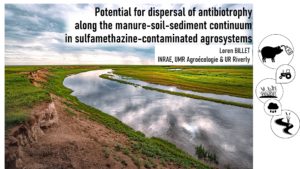Dr Loren Billet, who successfully defended her PhD Thesis on December 2021 will present her main results during the next EcotoxicoMicYR webinar.
EcotoxicoMicYR Webinar: Tuesday, March 22, 2022 (10:30 am, Paris Time Zone)
Free Registration: https://register.gotowebinar.com/register/1019690803100290059
(Please note that all Young Researchers in Microbial Ecotoxicology who are interested to present their PhD Thesis or Post-Doc work are welcome for future webinars. Please feel free to contact EcotoxicoMicYR at ecotoxicomicyr@gmail.com)

Title:
Abstract: An emerging function in the scientific literature, antibiotrophy is the bacterial capacity to metabolize antibiotics. Considered a bioremediation tool, it remains a health risk due to its association with antibiotic resistance. The first goal of this thesis was to study its dispersion within agrosystems contaminated with antibiotics during two coalescence events, i.e. manure spreading on the soil and its erosion towards the aquatic compartment. Experiments have shown the systematic invasion of the soil and sediment bacterial communities by the antibiotroph Microbacterium sp. C448 when sulfamethazine is present but not necessarily mineralized. The antibiotic would have a double function towards this strain: to decrease the competition by its biocidal action on the community and to constitute an exclusive nutritive source when necessary. This work also reports the isolation of two new antibiotrophic strains from natural river sediments that are phylogenetically and functionally close to those already known. This highlights the underestimated ubiquity of the antibiotrophy function and its probable recent widespread dispersal. Addressing the theme of bacterial dispersal in general, these experiments have highlighted bacterial transfers between different environmental compartments that can be influenced by antibiotic contamination, thus calling for the need to focus on the specific case of antibiotic-resistant bacteria.
Keywords: sulfonamide biodegradation, antibiotic resistance, bacterial coalescence, bacterial community, erosion, manure application.

